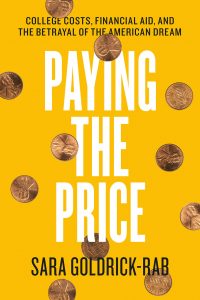Paying the Price: The Student Debt Crisis and Its Deniers

Sara Goldrick-Rab’s Paying the Price is the hammer that hits the point home in Elizabeth Tandy Shermer’s “The Student Debt Crisis and Its Deniers,” over at Public Books. More after the jump.
***
Sara Goldrick-Rab doesn’t think a disaster is coming; instead, she believes it is already here. The few years of data that Baum, Akers, and Chingos parsed may have indicated that the status quo is fine, but the emergence of a new higher education economy is painfully clear from Goldrick-Rab’s parsing three decades of both policy changes and economic trends. The financial assistance underpinning the entire higher education system doesn’t lessen inequality—but actually exacerbates it. Tuition costs, as Goldrick-Rab points out, were once low enough that students could easily choose to either borrow or work their way through school. Her book, Paying the Price: College Costs, Financial Aid, and the Betrayal of the American Dream, documents that fees and expenses now force most students to do both, even those from low-income families who qualify for federal grants and work-study opportunities on campus. Of course, offsite part-time jobs are more readily available, but rarely pay enough or have schedules suitable for students studying full time (a prerequisite for maximum state, federal, and often private support).
Affording school has become increasingly difficult for poor, working-class, and middle-class enrollees. Between 2003 and 2013, family income dropped for almost 80 percent of Americans. Those years also coincided with massive cuts to state expenditures for higher education. As a result, fees soared in years when college degrees conversely became more important than before. So Baum may be right that a little more than 40 percent of Americans never enrolled in advanced coursework, but almost 60 percent of Americans have felt the need to at least attempt to get some postsecondary instruction.
Goldrick-Rab (unlike Baum, Akers, and Chingos) isn’t convinced that completing a degree program all but guarantees a return on investment. Getting ahead is actually at the whim of “the ever-shifting labor market … rife with uncertainty and ongoing change and, too often, discrimination to boot. People who grow up in economically fragile circumstances often continue to live in economically fragile communities, even after they attend college.” They also are more likely to enroll in for-profit institutions. They don’t need more data to make a better choice; their K–12 schooling, family obligations, and work schedules really don’t give them any other options.
Goldrick-Rab didn’t reach those conclusions from crunching numbers or reading news stories. She ran an innovative, interdisciplinary, six-year study (2008–14) of 3,000 broadly representative students, six of whom she profiles in depth. All came from families with an adjusted gross-income under $25,000, all were accordingly on financial aid, and all were from Wisconsin, the “‘mythical microcosm’…[that] comes closer than any other to national averages on key measures such as income, education, and neighborhood characteristics.”
***
To read Shermer’s piece in full, click here.
To read more about Paying the Price, click here.